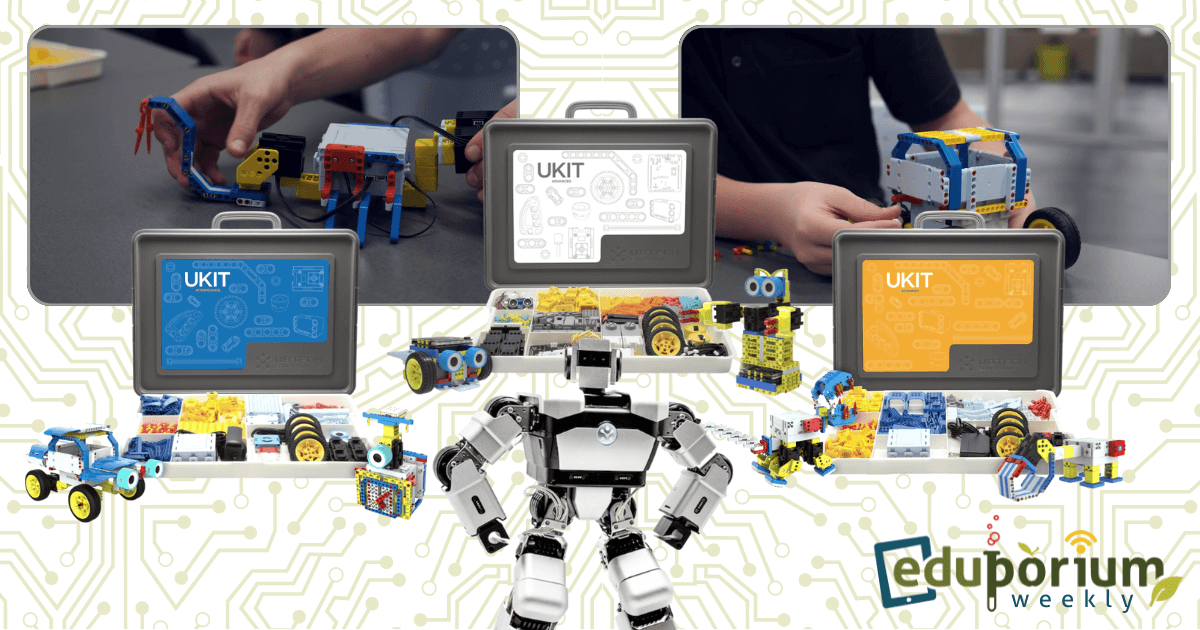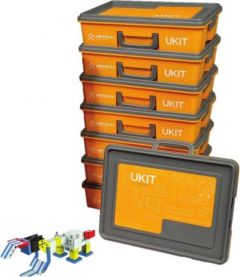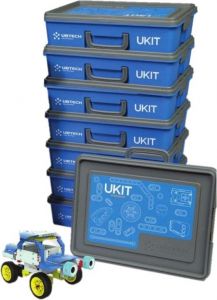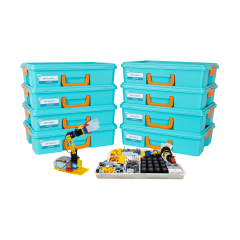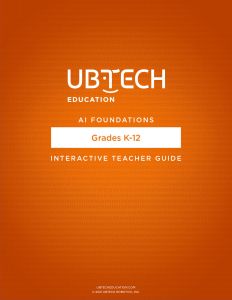The line of UBTECH Education kits are very engaging for students, offering them hands-on engineering, coding, and problem-based learning with various components and sensors. This week, we’re breaking down the five robotics and coding kits on our store, what comes in each package, the curriculum add-ons, and what students can do in the classroom. With something for students in elementary, middle, and high school, the UBTECH line (the three UKITs, the ChampBot Bundle, and the JIMU Maker KIT) helps enable STEM-based learning.
UBTECH UKIT Beginner
So, let’s start at the beginning with (you guessed it) the UKIT Beginner. The UKIT Beginner is for elementary school students and includes over 300 pieces for building robot models. Each of the models are laid out in the guides and, if using the uKit EDU mobile app, students can also find digital guides for each project. This kit is perfect for robotics for elementary students and it's also ideal for classroom use. The UKIT Beginner curriculum provides a valuable base for both students and teachers. It also helps teachers reinforce STEM instruction as students work on hands-on creations. As they progress through the projects, students will build computational thinking and problem solving skills that will serve them well in both the short and long term.
What comes in the UBTECH Beginner kit?
The Beginner Kit is ideal for groups of 2-4 students but they can also use it on an individual basis. Despite its 368 pieces, it’s still an entry-level robotics kit and many of the pieces are easy to use. They include plastic wheels and connectors so students can build robots that are both sturdy and mobile. The kit also includes four servo motors, so students can program their robots to do all sorts of actions using the UBTECH Edu app. There are 13 pre-designed models but, if students really want to get creative, they can design their own STEAM activities.
The UKIT EDU app and the Beginner Kit.
For school use, the Beginner Kit also comes with a sturdy storage bin, which is helpful for moving kits between classrooms. The UBTECH Edu app works on iOS and Android devices and features an immersive 3D environment for coding. Not only are the guides interactive, but students can then code in a Blockly language or using Pose-Record-Play. Finally, the custom curriculum supplements the experiences students want and, for teachers, it’s aligned to NGSS standards. It’s downloadable and printable and includes up to 15 hours worth of STEAM learning, which makes the kit a great option for starting out with the UBTECH line.
UBTECH UKIT Intermediate
The Intermediate Kit is similar to the Beginner Kit in that it supports classroom collaboration and groups of 2-4 students. It also help kids learn more about coding using a block-based language and it's compatible with the iOS and Android UBTECH Edu app. As implied, it's a bit more advanced than the Beginner Kit. It includes over 500 pieces for students to build more in-depth projects. Many of those pieces are the same as in the Beginner Kit but there are some new ones as well. The projects students can build with this kit are more complex with increasingly challenging designs and they’re able to explore the UBTECH sensors more while using this kit. Guides for the 15 pre-designed models are available in the UBTECH Edu app as well.
UBTECH UKIT Intermediate parts and lessons.
The pieces in this kit are the main control box, a rechargeable battery, connecting cables, four digital servo motors, a touch sensor, an infrared sensor, a Bluetooth speaker, two LED modules, and a storage bin. Using these pieces, students can build all sorts of models, like a windshield wiper, the Mybot, which helps them learn about the five senses, and a lot more. These lessons help students explore some key and exciting STEM topics, like physical science, earth science, and engineering. Plus, as students work together to complete each of the builds, they’re also building key skills that will help prepare them for college and careers—design thinking, leadership, persistence, troubleshooting, computational thinking, and more.
Benefits of the UKIT Intermediate.
Teachers can also download or print the curricular materials for the Intermediate Kit, which cover plenty of NGSS-aligned topics. It's also full of project-based learning lessons that supplement science instruction with hands-on STEM experiences. Besides building the different robot models, students can try different types of coding with the UBTECH Edu app. In building one of the projects (the Trolley), they can use the infrared sensor and create code to get the robot to sense and avoid obstacles as it moves around. These projects really help students build critical thinking skills and the fact that they can take part in both advanced and age-appropriate learning is just one more reason this kit is great.
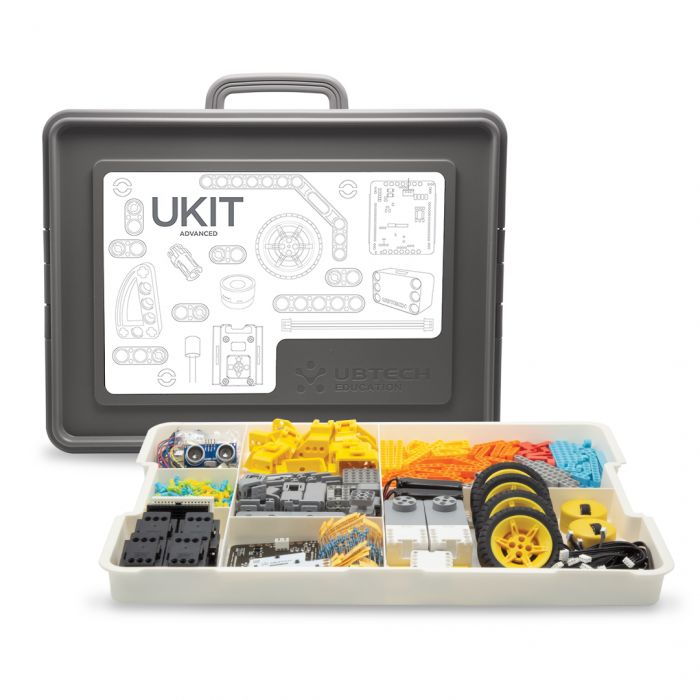
UKIT Advanced
With the UKIT Advanced, things start to get a little more interesting. The premise stays the same as with the Beginner and Intermediate kits, but learning with the Advanced Kit is, well, more advanced. Students can try some open-ended STEAM projects and explore robotics in a more in-depth way. It’s great for kids who have some robotics and coding practice—and ideal if they've used the Beginner or Intermediate kits. The component list is more sophisticated and versatile, allowing students to go beyond simply building and programming robots. They can look at the mechanics, electronics, and coding that’s behind real, high-tech robotic systems. Plus, they can take in some pretty cool lessons while doing so.
The pieces in the UBTECH Advanced Kit.
Like the Beginner and Intermediate kits, the Advanced Kit is ideal for student groups of 2-4 or in individual learning. Totaling over 700 pieces, students can truly take part in amazing hands-on experiences. They can follow the project guides or, once again, get creative and put their own twist on the models. The pieces in the Advanced Kit include an Arduino processor, a rechargeable battery, breadboards, resistors, 16 digital servo motors, a controller module, a grayscale sensor, a pressure and touch sensor, a Bluetooth module, two LED modules, the cables, and the storage bin. As you might be thinking, these advanced sensors and parts help students create some truly unique projects. And, those projects have an entirely new option for coding.
The UKIT Advanced and uCode.
While students can program their Beginner and Intermediate kit projects with the UBTECH Edu app, coding with the Advanced Kit is different. The Advanced Kit requires the use of the UBTECH uCode software, which runs on computers. It’s a more advanced coding software that's compatible with the Arduino IDE. The uCode software is free to use and download on Windows and Mac devices or simply through a browser. After building their robots, they can program them using Blockly, Scratch, Python, C, or C++ for the chance to try a handful of new languages. Finally, the project-based curriculum includes lessons on topics like engineering, AI, coding, and circuitry.
JIMU Maker KIT
In addition to their UKIT’s, another UBTECH product line for STEM learning is the JIMU Maker KIT. This bundle of five JIMU Robot kits helps teachers lead in-depth, hands-on lessons in just about any environment. Like the UKITs, the JIMU Maker KIT includes pre-designed models students can construct. There are 10 projects in total with illustrations in the guides that are very clear and helpful. To really get creative, students can also try designing their own models. In their experiences with the JIMU Maker KIT, students will learn key engineering, planning, design, and coding skills as they build robots.
Get to know the JIMU Maker KIT.
Like we said, the JIMU Maker KIT includes five UBTECH JIMU robots—the entire JIMU robot family. There is one ChampBot, FireBot Kit, UnicornBot, Overdrive Kit, and the Cosmos Kit. Students can build each robot and then take their learning further by programming their actions using block code. There are over 2,300 pieces in the kit and students don't need any additional tools to build the models. Once built, students can use code to control their actions, like navigating obstacles, picking things up, illuminating LED lights, making sounds, and more. The kit also comes with 20 Spark Starter cards to help teachers integrate STEAM activities into learning.
The JIMU Robot app.
The JIMU Robot KIT also has its own app students can use with their inventions. Students can find the design plans and construction steps for the models using the 360-degree format on the app. Coding is block-based with easy drag-and-drop elements for creating programs in the field. Pose-Record-Play is also a coding option within the JIMU Robot app, letting students control the robot’s motors, lights, and sensors with code. The JIMU app is available on iOS and Android devices and the JIMU Maker KIT is available on our store.
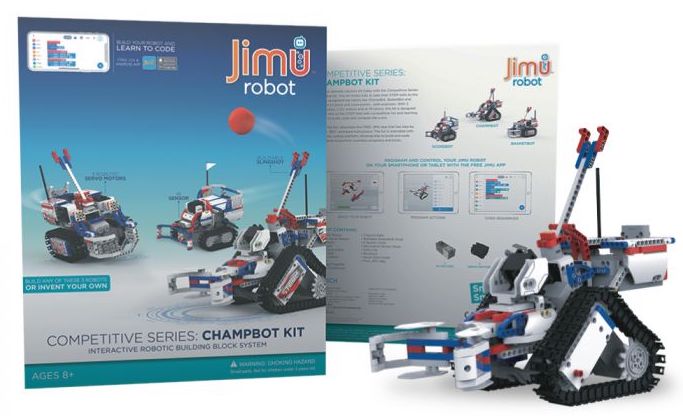
ChampBot Bundle
The final UBTECH kit on our store (at the moment) is the Competitive Series: ChampBot Bundle. Also, the ChampBot is one of the kits included in the JIMU Maker KIT and this bundle is even bigger. It has eight ChampBot kits to enable collaborative learning for as many as 32 students. They could also use it individually as well. The ChampBot is for K-8 students and involves building robot models and then programming them. Like the other UBTECH kits, it can help spark a genuine interest in STEM education in the classroom. And, it also allows for easy transitions between learning environments if using them with different classes in different classrooms.
The ChampBot curriculum and components.
The ChampBot Bundle is based around its own included curriculum, which is free with the kit. It includes an extra AI Foundations curriculum as well and a 2-hour live PD session for teachers who want to learn about integrating it in the classroom. Though up to four students can use a ChampBot, the ideal ratio is one or two students per robot. The kit includes over 500 pieces in total—many of the same ones you’ll find in the other UBTECH kits. There are three servos, a control box, a USB charger, two DC motors, an IR sensor, and some accessories. The kit also works with the JIMU Robot app on Android and iOS devices.
Building the UBTECH ChampBot models.
There are three different models students can build: the ChampBot, BasketBot, or the ScoreBot. Once built, they can use the app to program all sorts of movements and actions, like getting the robot to shoot baskets or knock down one of the included target cards. There are no tools necessary for building any of the models and there are instructions in the JIMU app. We should also mention that the curriculum helps teachers transition smoothly between in-person and virtual learning. Also, that curriculum is only available with the purchase of the bundle. An implementation guide is also included to assist with in-person, hybrid, and remote rollouts. To learn more about all of the UBTECH kits, please feel free to contact us!
To find all the UBTECH kits, visit our store. For the latest EdTech, STEM, and MakerEd news, follow us on Twitter and Instagram. Like us on Facebook, too, or sign up for our newsletter for our latest product news and offerings. If you have an idea for the next Eduporium Weekly theme, send us a message on social media or comment below.



